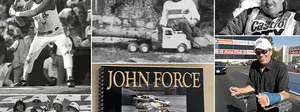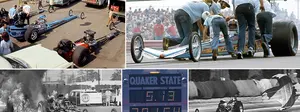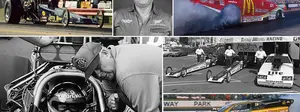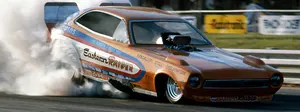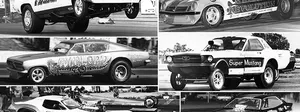

And, finally, ‘the Snake’ weighs in
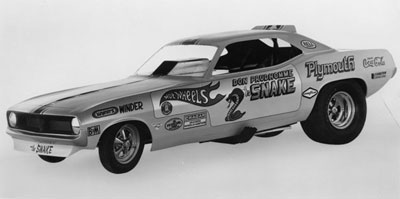
(Above) The "slightly off" Rapid Transit paint scheme and (below) the real deal.
|
 |

(Above) The same Rapid Transit car, new '91 grille treatment, another kinda-sorta paint scheme. (Below) This car on display at a Rapid Transit show.
|
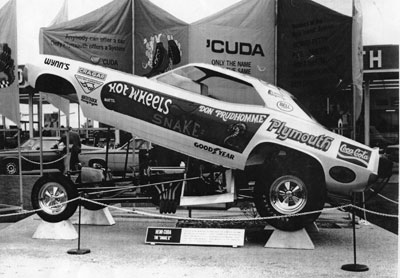 |
I use the word “finally” in the headline not as a measure of time – as in, “Well, he finally speaks about the subject” -- but to let Don Prudhomme himself bring a close to the subject of his early Barracuda Funny Cars. “The Snake” has been following with interest the discussions here in the last few weeks and wanted to help clear up a few topics we’ve discussed recently.
First off, he (like me) is really impressed with the depth and breadth of the knowledge and information we share here, and although he didn’t use the word, it’s pretty clear that he’s flattered that anyone still cares about the trivial details of a 40-year-old race car. “It’s amazing, isn’t it?” he marveled.
Prudhomme and Skip Allum also added some interesting new meat to the meal by sending a couple of the images at right, which came out of a 1970 Plymouth press kit. As we’ve already established, Ronnie Scrima at Exhibition Engineering built two matching Funny Cars for “the Snake’s” 1970 Funny Car debut. He ran one, and the other was used by Plymouth in its Rapid Transit rolling display. Prudhomme sold his car to Sammy Miller and Ken Poffenberger, and the car was heavily damaged or destroyed a few years later. Prudhomme and Willie Wolter found the Rapid Transit version and restored it, which is the car now in his possession, most usually strapped to the back of the yellow ramp truck.
The first thing you will note in the photos is that the Rapid Transit car does not exactly match the paint scheme of the race car, especially the “Snake” lettering.
“They built both of the cars at Scrima’s, and I didn’t really know much about what they were going to do with the other car,” Prudhomme admitted. “All I knew was it was a spare car. The next thing I knew, they shipped it to Detroit, where all of the Rapid Transit stuff was going together, and they painted it there like my car, probably off of photos they’d seen of my car. Unfortunately, it wasn’t the exact same paint scheme, more like the theme. Someone obviously used their imagination a bit. You can also see it has a flat grille where my car had a molded grille. I don’t know why they filled it in. The car went on the tour, and I never did ask them to change it. I never really gave it much thought because the cars just didn't cross paths. We were racing, and the other car was pretty much going to dealerships.
“The following year, when we built the Buttera car and added the white paint scheme and the red flames, they updated the Rapid Transit car, too, and that wasn’t exact either. The flames are a lot different, and they changed the grille, too, for the next model-year Barracuda.”
 |
The roof spoiler: Time for more corrections of an age-old assumption. We started talking about the notorious short-lived roof-mounted spoiler on the car when it debuted in 1970, which almost everyone I know thinks was put there by some well-meaning Plymouth engineer who knew nothing about Funny Cars. Truth is, it was the idea of the team itself.
“When we built the cars, we thought it would look pretty cool to have the spoiler on the roof instead of the rear deck,” Prudhomme admitted. “We thought we could just move it forward and it would have more downforce being way up there and plant the whole car. Plus we thought it just looked cool. Unfortunately, that’s not how aerodynamics work. I read somewhere that someone said we took it off because it was picking up the front wheels, but it was the complete opposite of that. I remember running the car at Pomona, one of the first times out with the car, it started to spin the tires near the finish line. It was actually picking the back end off the ground. [Larry] Maxwell at Chrysler said, ‘You’ve got to get those things off of there; that’s not right. You need to put them in the back, and here’s why.’ The air was coming off that spoiler and tumbling and picking the back end up. So we cut them off and put them on the back, and it was like night and day. “
 |
The front-spoiler lip: One discussion on aerodynamics led to another, so I asked “Snake” about the front spoiler that reader Jon Hofmann had pointed out. Prudhomme definitely remembered the spoiler extension that debuted early in 1973 but mysteriously disappeared later that season.
“We added an aluminum lip to the spoiler to keep air from getting under the car, like a cowcatcher,” he said. “No one at that time really had a car that was that low, but we were just trying to figure out how low we could go. It was great. It was just about scraping the ground, and it really helped a lot, but NHRA made us take it off because it was messing with the lights, both in staging the car and at the finish line. If you remember, back then, the lights were a lot higher off the ground than they are today. I think that shortly after that they came up with a spoiler-height [ground-clearance] rule. None of us knew much about aerodynamics back then, and no one was putting a car in a wind tunnel, but we made so many runs back then that we could do stuff like that and figure out pretty quick whether something worked or not. It was all just trial and error.”
The black Snake III 'Cuda: “We just didn’t have time to paint it,” he admitted. “I thought it looked pretty cool and would have loved to have left it that way. It was just primer with the decals on it, so it was real lightweight without the paint.” Prudhomme couldn’t remember how many events he ran with the car nor about the Beeline appearance speculated upon recently.
The “other” black car: I asked Prudhomme about the second black 'Cuda, which ran for a short time in 1973 after a fire at Green Valley Race City. He couldn’t recall the details or the amount of damage inflicted in the fire that might have caused him to get a new body but thinks that was the case. “It probably was a new body because they didn’t last long,” he said. “We went through several bodies. They were just fiberglass. You’d have a date coming up, and if you couldn’t get it painted in time, you’d put whatever decals on that you needed to put on, then paint it when you got a chance. I think we did that several times.”
 |
The red Duster: There was a bit of a brouhaha when Prudhomme and Co. unveiled the restored ex-Tom McEwen Dodge ramp truck because they also repainted the blue “Mongoose” Duster they already had on hand to match the truck. While the truck itself rightfully drew raves, plenty of folks seemed upset that the Funny Car wasn’t the perfect mate like Prudhomme’s yellow 'Cuda was for his own restored truck. The McEwen Duster was in no way original -- nor ever represented to be; it was a display piece for the 35th anniversary Hot Wheels celebration a few years ago – and was just a convenient addition to the truck. The body and chassis were not right, nor was some of the lettering on the car, but eventually, cooler heads prevailed, and everyone got into the spirit of the display.
“This McEwen car thing, I think you explained it well,” said Prudhomme. “All it really is is a prop on the back of the truck because it’s not the real car. I suppose that if I had made the paint scheme exactly like the old car, people would have said, ‘Well, it’s still not the real car,’ so it is what it is. If it bothers people that much, I guess we could fix the paint, but it’s still not the real car, y’know? The cool thing would be for someone to find the original car, then I’d be all over that, but it’s not. To me, it’s like a hairpiece: No matter how you comb it, it’s still a hairpiece.”
I’m not going to get into a whole “What happened to the real red Duster?” but I may try to talk to John Collins, who, as we understand it, may have been the next owner. But it’s time to move on. Thanks, "Snake."

OK, so I fibbed; “Snake’s” not going to get the final word, but only because after I talked to him Tuesday, I received a couple of interesting emails that kind of round out the discussion but also leave a little sense of mystery, as probably befits anything historic.
Michael Rabenau put on his Sherlock Holmes hat and magnifying glass and detected a couple of subtle differences about the first 'Cuda Funny Car, and I dug out a couple of photos from our file to back up his point. The black and white is from the 1970 Winternationals (the "roof flap car"), the other also from 1970, but no month is available.
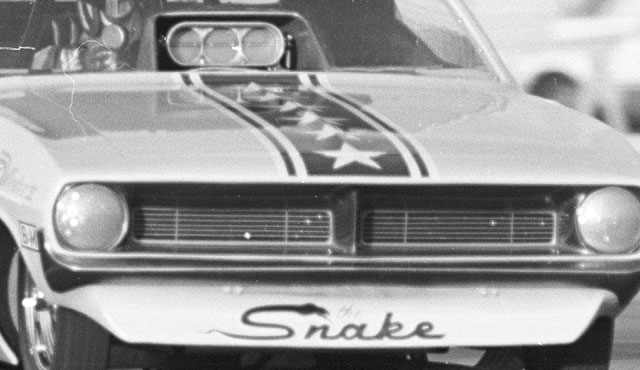 |
 |
"Look at the front grille," he cited. "There is no Plymouth logo on the roof flap car. [The other version] had it as well as two cartoon roadrunners on the driver’s side above the grille. I'm not sure if the Plymouth logo was molded into the fiberglass or a decal. I thought maybe the windshield injector opening was a clue, but I've seen round and square openings on both cars. Hope this helps, but it'll probably make things worse!”
Excellent work, Mike. Note also the change in the "Snake" lettering on the front spoiler, which gained a white outline. However, we do know from photos that once the roof spoiler was removed, the original body stayed in business at least for a while. At first I thought this might be just minor cosmetic work done after a fender bender or something that forced a front-clip fix, although as Prudhomme noted above, he (and others) went through quite a few bodies in those days. The injector opening looks significantly different, but upon close inspection, you can see it's the same tin but with a slot cut into a full windshield, which now covers most of the tin.
BUT ... If you scroll down to the post before this, though, you can see in the first photo-gallery image the roof spoiler still on but the new windshield treatment. The second photo, showing the car spoilerless, has returned to a conventional injector opening. Maybe there are more 'Cuda bodies than we believed, or maybe it's just a series of additions/deletions to the original.
Then there's the photo below, from the season-ending Supernationals at Ontario Motor Speedway, showing the new John Buttera car car with a '71-model grille treatment. Closer inspection also reveals a different injector opening and roof/hood stripe (note the width and number of the "outside" stripes). Another new body? Here comes that headache again ...
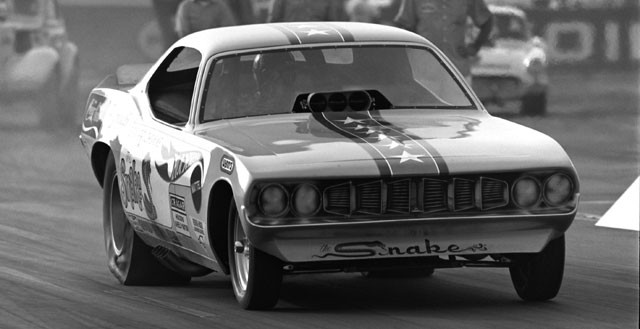 |


Artist's conception (Jimmy Hoffa figure not included)
|
OK, before we (really this time) close this chapter, we have to end it with a cliff-hanger. People might not know where Jimmy Hoffa's body is buried, but what about “the Snake’s” 'Cuda body?
I heard from longtime Florida pal Steve Gruenwald, who befriended Poffenberger in his later years.
“He had moved down here to Palm Beach Gardens, Fla., to retire,” reported Gruenwald. “He had a street rod that he took to a friend’s shop for some work. My friend, Wayne Smozanek, ran a blown Willys, and Ken took interest. He then told Wayne about his past racing exploits. Wayne told me about this former Funny Car racer whom he had met. I finally got to meet him, and he was surprised that I knew so much about his cars. I showed him the Super Stock & Drag Illustrated with the article on his Corvair Funny Car, and we hit it off. We talked about his rides, and I knew that he had driven the ex-Prudhomme 'Cuda. He told me before he died that the back half, from the firewall back, was in a container at his old gas station, which his son still ran. I went to the CHRR in 2009. I saw Prudhomme and told him what I knew, and he said he had heard the same story. He tried to contact [Poffenberger’s] son but never got a return call, so he blew it off. It is a shame Ken is not here to straighten this mess out.”
Indeed. And, with that, we say goodbye to the "Snake" Cuda thread and move on. I'd wager it's not the last time the subject in broached, but for now: case closed.
























